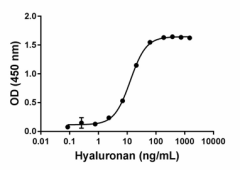- Regulatory Status
- RUO
- Other Names
- CD44 antigen, Extracellular matrix receptor III, ECMR-III, GP90 lymphocyte homing/adhesion receptor, HUTCH-I, Hermes antigen, Hyaluronate receptor, Lymphocyte antigen 24, Ly-24, Phagocytic glycoprotein 1, PGP-1, gp85, H-CAM

-

Immobilized recombinant mouse CD44 at 1 µg/mL binds biotinylated hyaluronan in a dose-dependent manner. The ED50 for this effect is 6 – 36 ng/mL. -

Stability Testing for Recombinant Mouse CD44. Recombinant Mouse CD44 was aliquoted in PBS, pH7 at 0.2 mg/mL. One aliquot was frozen and thawed four times (4x Freeze/Thaw) and compared to the control that was kept at 4°C (Control). The samples were tested for their ability to bind biotinylated hyaluronan in a dose-dependent manner using a functional ELISA. The ED50 for this effect is 6 – 36 ng/mL.
| Cat # | Size | Price | Quantity Check Availability | ||
|---|---|---|---|---|---|
| 784102 | 10 µg | $112.00 | |||
| 784104 | 25 µg | $229.00 | |||
Select size of product is eligible for a 40% discount! Promotion valid until December 31, 2024. Exclusions apply. To view full promotion terms and conditions or to contact your local BioLegend representative to receive a quote, visit our webpage.
CD44, also known as Hermes antigen, PGP-1, H-CAM, or HUTCH-I, is an 80-95 kD glycoprotein. CD44 is a major receptor for hyaluronan (HA). Other ligands to CD44 were identified in the extracellular matrix (ECM), such as fibronectin, laminin and type I collagen. CD44 is expressed on all leukocytes, endothelial cells, hepatocytes, and mesenchymal cells. As B and T cells become activated or progress to the memory stage, CD44 expression increases from low or middle levels to high levels. Thus, CD44 has been reported to be a valuable marker for memory cell subsets. High CD44 expression on Treg cells has been associated with potent suppressive function via high production of IL-10. CD44 is an adhesion molecule involved in leukocyte attachment to and rolling on endothelial cells, homing to peripheral lymphoid organs and to sites of inflammation and leukocyte aggregation. CD44 associates with ezrin/radixin/moesin (ERM) proteins and serves as a platform to link the extracellular matrix and the actin cytoskeleton. Membrane-type I matrix metalloproteinase (MT1-MMP) ADAM-like protease mediates constitutive shedding of the common form of CD44 in many types of cells and human tumor tissues. Proteolytic cleavage of the ectodomain of CD44 is induced by various stimulations, such as calcium influx and the activation of PKC, Rac and Ras oncoproteins. Release of the soluble form of the ectodomain is responsible for the regulation of the interaction of CD44 and the ECM during cell adhesion, migration, and invasion.
Product Details
- Source
- Mouse CD44, amino acid (Gln25-Thr224) (Accession: #NP_033981.2), with a linker (GSSR) and a C-terminal human IgG1 (Pro100-Lys330), was expressed in 293E cells.
- Molecular Mass
- The 435 amino acid recombinant protein has a predicted molecular mass of approximately 48.48 kD. The DTT-reduced and non-reduced protein migrates at approximately 70 kD and 140 kD by SDS-PAGE, respectively. The predicted N-terminal amino acid is Gln.
- Purity
- >95%, as determined by Coomassie stained SDS-PAGE.
- Formulation
- 0.22 μm filtered protein solution is in PBS pH7.2.
- Endotoxin Level
- Less than 0.1 EU per μg protein as determined by the LAL method.
- Concentration
- 0.2 mg/ml
- Storage & Handling
- Unopened vial can be stored between 2°C and 8°C for up to 2 weeks, at -20°C for up to six months, or at -70°C or colder until the expiration date. For maximum results, quick spin vial prior to opening. The protein can be aliquoted and stored at -20°C or colder. Stock solutions can also be prepared at 50 - 100 µg/mL in appropriate sterile buffer, carrier protein such as 0.2 - 1% BSA or HSA can be added when preparing the stock solution. Aliquots can be stored between 2°C and 8°C for up to one week and stored at -20°C or colder for up to 3 months. Avoid repeated freeze/thaw cycles.
- Activity
- Mouse CD44 binds biotinylated hyaluronan with an ED50 of 6 – 36 ng/mL in a functional ELISA when immobilized at 1 µg/mL.
- Application
-
Bioassay
- Application Notes
-
BioLegend carrier-free recombinant proteins provided in liquid format are shipped on blue ice. Our comparison testing data indicates that when handled and stored as recommended, the liquid format has equal or better stability and shelf-life compared to commercially available lyophilized proteins after reconstitution. Our liquid proteins are verified in-house to maintain activity after shipping on blue ice and are backed by our 100% satisfaction guarantee. If you have any concerns, contact us at tech@biolegend.com.
Antigen Details
- Structure
- Homodimer
- Distribution
-
All leukocytes, epithelial cells, endothelial cells, hepatocytes, mesenchymal cells; plasma membrane.
- Function
- Leukocyte attachment and rolling on endothelial cells, stromal cells and ECM.
- Interaction
- CD44 interacts with HIF-2α and improves HIF target gene activation.
- Ligand/Receptor
- Hyaluronan, MIP-1β, fibronectin, collagen, laminin and other glycosaminoglycans.
- Bioactivity
- Immobilized recombinant mouse CD44 at 1 µg/mL binds biotinylated hyaluronan in a dose-dependent manner.
- Cell Type
- B cells, Granulocytes, T cells, Tregs
- Biology Area
- Cell Adhesion, Cell Motility/Cytoskeleton/Structure, Immuno-Oncology, Immunology
- Molecular Family
- Adhesion Molecules, Blood Group Markers, Soluble Receptors
- Antigen References
-
- Melrose J, et al. 1996. Electrophoresis. 17:205.
- Yang B, et al. 1995. Anal Biochem. 228:299.
- Yonemura S, et al. 1998. J Cell Biol. 140:885.
- Bourguignon LY, et al. 2007. J Neurochem. 101:1002.
- Nakamura H, et al. 2004. Cancer Res. 64:876.
- Nagano O and Saya H. 2004. Cancer Sci. 95:930.
- Legg JW, et al. 2002. Nat Cell Biol. 4: 399.
- Johansson E, et al. 2017. Cell Rep. 20:1641.
- Gene ID
- 12505 View all products for this Gene ID
- UniProt
- View information about CD44 on UniProt.org
